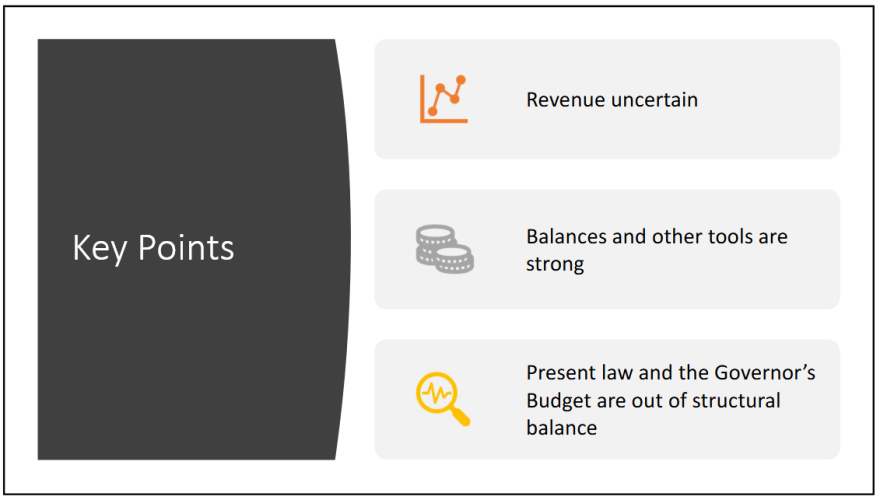The first state budget offered by Gov. Greg Gianforte includes tax cuts and a marginal increase in general fund spending.
Gianforte campaigned on the promise of holding the line on state spending and bringing economic prosperity to Montana. The governor’s budget director, Kurt Alme, told lawmakers during a presentation last week that the Gianforte administration has four main goals under that umbrella.
"Getting our economy going, getting Montanans back to work in good-paying jobs by encouraging entrepreneurship, and reforming the tax code with broad based reductions and some targeted decreases."
Big picture, Gianforte’s proposed budget would increase general fund spending by 2.5% over the biennium when adjusted for inflation.
It also suggests cutting the state’s top individual income tax rate from 6.9% to 6.75%, exempting new businesses that bring long-term jobs to Montana from the state’s capital gains tax, and eliminating the business equipment tax for roughly 4,000 businesses.
Those tax cuts mean less revenue for the state. Gianforte’s administration proposes cushioning that revenue hit by asking state agencies to absorb a 4% staff vacancy savings over the biennium and to find other efficiencies to save money.
Gianforte is also asking lawmakers to split allocations of new marijuana tax revenue dollars between substance abuse prevention programs and the general fund.

Amy Carlson is director of the Legislative Fiscal Division, which provides non-partisan budget and data analysis for lawmakers considering how best to balance the state budget. She offered her division’s analysis of Gianforte’s budget last week.
Carlson said Gianforte’s budget proposes to spend more money over the next two years than the state is projected to bring in. Carlson says the budget outline has a roughly 2% negative structural balance, equal to about $59 million.
“This makes me feel uncomfortable, but I think you need to keep an eye on what happens to your revenue estimates over the next several months, and keep an eye on this and see what you, at the end of the day as the Legislature, works for you."
Carlson qualified that it may be prudent to operate with a negative structural balance in a year filled with economic uncertainty caused by the COVID-19 pandemic.
Gianforte’s budget outlines a reserve of $300 million to cushion the state’s general fund.
“The really good news is that we have very strong balances, and we’ve got a very solid, very well-thought-out toolbox for dealing with volatility in the Montana budget," Carlson said.

Alme, with the governor’s budget office, says his analysis also shows the budget proposing to spend more than the state will earn, but slightly less than the $59 million Carlson’s division projects. He’s optimistic that policies outlined in the budget will increase state revenues enough to account for it.
“We’re hoping for strong revenue growth as we move through the biennium and also, as an insurance, we also want to highlight what Director Carlson said, which is the strong ending fund reserves," Alme said.
Rep. Llew Jones, a Republican from Conrad, is chair of the powerful House Appropriations Committee that’s charged with building the state's budget. He agreed the state’s saving accounts are healthy, but said that new revenue is not guaranteed to balance out the budget.
“I’m sure that will be an ongoing discussion - A $50 million negative statutory cash flow is concerning," Jones said.
Bob Story, executive director of the Montana Taxpayers Association and a former Republican lawmaker, said in an interview he thinks Gianforte’s tax cuts will generate revenue for the state by luring in new businesses that can create jobs.
“The more workers you have, the more opportunity for more Montanans to stay here and work and get jobs and then, of course, the more income tax revenue you generate," Story said.
He said the Taxpayers Association is encouraged by what it sees in the proposed budget.
According to an analysis of Gianforte’s budget by the Montana Budget and Policy Center, a Helena-based organization that advocates for social services for people with low incomes, the average tax cut for someone with income below $63,000 would be less than $14.
House Minority Leader Kim Abbott said on a call with the press last week that Democrats are encouraged by Gianforte’s proposal to invest more money in career and technical training, but "It looks like the tax cuts are going to the wealthiest Montanans," she said. "If we’re going to provide tax breaks, we’d like it to be laser focused on the folks that had the hardest time over the last year.”
Alme said that because wealthy people pay more in taxes in Montana, they subsequently see a higher cut when it’s applied across the board.
“Again, the important thing here isn’t the, I mean at those bottom level rates, our rates are very small and the income levels are very small, so the taxes paid are very small," Alme said. "What the importance of, I think, this is, is how critical this rate is to business owners in making decisions of where to locate."
He also said the administration will put out a list of bills they’ll ask legislators to carry through the policy-making process to help realize Gianforte’s proposed budget. Lawmakers can tweak the budget as they like, and as new state revenue estimates come out.



